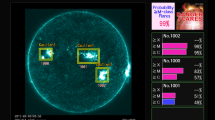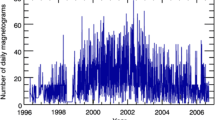Abstract
We have developed a set of daily maximum flare-flux forecast models for strong flares (M- and X-class) using multiple linear regression (MLR) and artificial neural network (ANN) methods. Our input parameters are solar-activity data from January 1996 to December 2013 such as sunspot area, X-ray maximum, and weighted total flare flux of the previous day, as well as mean flare rates of McIntosh sunspot group (Zpc) and Mount Wilson magnetic classifications. For a training dataset, we used 61 events each of C-, M-, and X-class from January 1996 to December 2004. For a testing dataset, we used all events from January 2005 to November 2013. A comparison between our maximum flare-flux models and NOAA model based on true skill statistics (TSS) shows that the MLR model for X-class and the average of all flares (\(\mathrm{M}{+}\mathrm{X}\)-class) are much better than the NOAA model. According to the hitting fraction (HF), which is defined as a fraction of events satisfying the condition that the absolute differences of predicted and observed flare flux on a logarithm scale are smaller than or equal to 0.5, our models successfully forecast the maximum flare flux of about two-thirds of the events for strong flares. Since all input parameters for our models are easily available, the models can be operated steadily and automatically on a daily basis for space-weather services.



Similar content being viewed by others
References
Ahmed, O.W., Qahwaji, R., Cloak, T., Higgins, P.A., Gallagher, P.T., Bloomfield, D.S.: 2013, Solar Phys. 283, 157. DOI .
Barnes, G., Leka, K.D.: 2008, Astrophys. J. Lett. 688, L107.
Barnes, G., Leka, K.D., Schumer, E.A., Della-Rose, D.J.: 2007, Space Weather 5, S09002. DOI .
Bobra, M.G., Couvidat, S.: 2015, Astrophys. J. 798, 135. DOI .
Bloomfield, D.S., Higgins, P.A., McAteer, R.T.J., Gallagher, P.T.: 2012, Astrophys. J. Lett. 747, 41. DOI .
Bornmann, P.L., Shaw, D.: 1993, Solar Phys. 150, 127. ADS . DOI .
Bradski, G.: 2000, OpenCV library. Dr. Dobb’s J. 150, 127.
Colak, T., Qahwaji, R.: 2009, Space Weather 7, 12. DOI .
Crown, M.D.: 2012, Space Weather 10, 6. DOI .
Pesnell, W.D., Thompson, B.J., Chamberlin, P.C.: 2012, Solar Phys. 275, 3. DOI .
Domingo, V., Fleck, B., Poland, A.I.: 1995, Solar Phys. 162, 1. DOI .
Doswell, C.A. III, Davies-Jones, R., Keller, D.L.: 1990, Weather Forecast. 5(4), 576.
Falconer, D.A., Moore, R.L., Barghouty, A.F., Khazanov, I.: 2014, Space Weather 12, 306. DOI .
Gallagher, P.T., Moon, Y.-J., Wang, H.: 2002, Solar Phys. 209, 171. DOI .
Graupe, D.: 2007, Principles of Artificial Neural Networks, 2nd edn. World Scientific Pub., Singapore, 6.
Lee, J.Y., Moon, Y.J., Park, Y.D., Fletcher, A.B.: 2007, Korean Astron. 40, 99.
Lee, K.J., Moon, Y.J., Lee, J.Y., Lee, K.S., Na, H.: 2012, Solar Phys. 281(2), 639. DOI .
Li, R., Zhu, J.: 2013, Res. Astron. Astrophys. 13(9), 1118.
Li, R., Wang, H., He, H., Cui, Y., Du, Z.: 2007, Chin. J. Astron. Astrophys. 7(3), 441.
Li, R., Cui, Y., He, H., Wang, H.: 2008, Adv. Space Res. 42, 1469. DOI .
McIntosh, P.S.: 1990, Solar Phys. 125, 251. DOI .
Qahwaji, R., Colak, T.: 2007, Solar Phys. 241, 195. DOI .
Riedmiler, M., Braun, H.: 1993, IEEE Internat. Conf. Neural Networks, 586. DOI
Sammis, I., Tang, F., Zirin, H.: 2000, Astrophys. J. 540, 583.
Scherrer, P.H., Bogart, R.S., Bush, R.I., Hoeksema, J.T., Kosovichev, A.G., Rosenberg, W., Springer, L., Tarbell, T.D., Title, A., Wolfson, C.J., Zayer, I. (MDI Engineering Team): 1995, Solar Phys. 162, 129. DOI .
Schou, J., Scherrer, P.H., Bush, R.I., Wachter, R., Covidat, S., Rabello-Soares, M.C., Bogart, R.S., Hoeksema, J.T., Liu, Y., Duvall, T.L., Akin, D.J., Allard, B.A., Miles, J.W., Rairden, R., Shine, R.A., Tarbell, T.D., Title, A.M., Wolfson, C.J., Elmore, D.F., Norton, A.A., Tomczyk, S.: 2012, Solar Phys. 275, 229. DOI .
Smith, S.F., Howard, R.: 1968, In: Kiepenheuer, K.O. (ed.) Structure and Development of Solar Active Regions, Internat. Astron. Union Sym. 35, Reidel, Dordrecht, 33. ADS .
Song, H., Tan, C., Jing, J., Wang, H., Yurchyshyn, V., Abramenko, V.: 2009, Solar Phys. 254, 101. DOI .
Sui, L., Holman, G.D., Dennis, B.R.: 2004, Astrophys. J. 612, 546.
Wang, H.N., Cui, Y.M., Li, R., Zhang, L.Y., Han, H.: 2008, Adv. Space Res. 42, 1464. DOI .
Xu, Y., Jing, J., Wang, S., Wang, H.: 2014, Astrophys. J. 787, 7. DOI .
Yuan, Y., Shih, F.Y., Jing, J., Wang, H.: 2010, Res. Astron. Astrophys. 10(8), 785.
Zharkov, S.I., Zharkova, V.V.: 2006, Adv. Space Res. 38, 868. DOI .
Acknowledgments
This work was supported by the BK21 plus program through the National Research Foundation (NRF) funded by the Ministry of Education of Korea, Basic Science Research Program through the NRF funded by the Ministry of Education (NRF-2013R1A1A2012763, 2013R1A1A2058409), and NRF of Korea grant funded by the Korean Government (NRF-2013M1A3A3A02042232).
Author information
Authors and Affiliations
Corresponding author
Rights and permissions
About this article
Cite this article
Shin, S., Lee, JY., Moon, YJ. et al. Development of Daily Maximum Flare-Flux Forecast Models for Strong Solar Flares. Sol Phys 291, 897–909 (2016). https://doi.org/10.1007/s11207-016-0869-2
Received:
Accepted:
Published:
Issue Date:
DOI: https://doi.org/10.1007/s11207-016-0869-2




